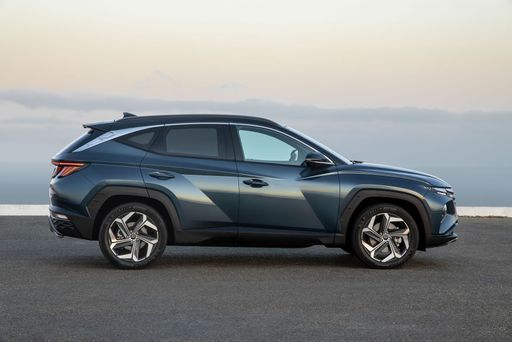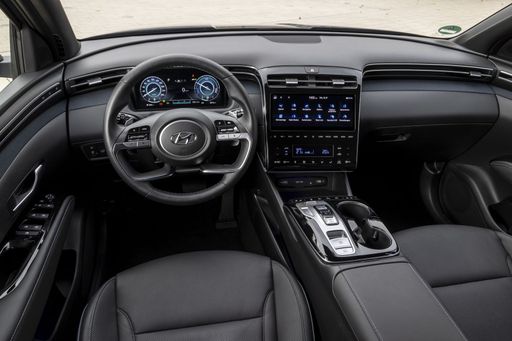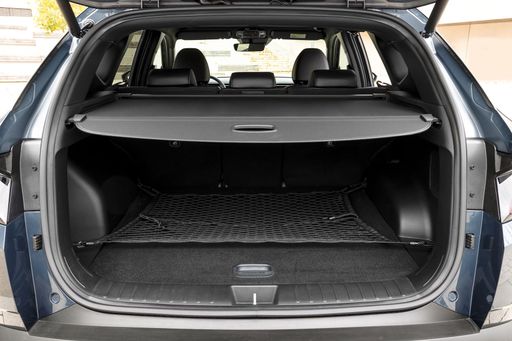Hyundai Tucson vs Mitsubishi Outlander - Diferencias y precios comparados
Costes y consumo
El precio y la eficiencia suelen ser los primeros criterios. Aquí se ve qué modelo mantiene la ventaja a largo plazo, ya sea repostando, cargando o al comprar.
Hyundai Tucson tiene una ventaja distinto en precio: parte desde 39900 €, mientras que el Mitsubishi Outlander cuesta 50800 €. La diferencia es de unos 10947 €.
También se aprecia una diferencia en el consumo: el Mitsubishi Outlander gasta 0.80 L y es notable más eficiente que el Hyundai Tucson, que consume 1 L. La diferencia es de unos 0.20 L cada 100 km.
En autonomía, el Mitsubishi Outlander ofrece un rendimiento ligeramente mejor: alcanza hasta 85 km, unos 15 km más que el Hyundai Tucson.
Motor y rendimiento
Potencia, par motor y aceleración dicen mucho sobre la experiencia de conducción. Aquí se ve cuál ofrece más dinamismo.
En cuanto a potencia, el Mitsubishi Outlander tiene una ventaja algo: 306 HP frente a 252 HP. Eso supone un aumento de unos 54 HP CV.
En aceleración de 0 a 100 km/h, el es más rápido: completa el sprint en , frente a del . Es aproximadamente más veloz.
En velocidad máxima, el Hyundai Tucson es ligeramente superior – alcanza 204 km/h, mientras que el Mitsubishi Outlander se queda en 170 km/h. La diferencia es de unos 34 km/h.
Espacio y practicidad
Ya sea coche familiar o compañero diario – ¿cuál ofrece más espacio, flexibilidad y confort?
Plazas: el ofrece más asientos – frente a .
En peso en vacío, el Hyundai Tucson es notable más ligero – 1542 kg frente a 2070 kg. La diferencia ronda los 528 kg.
En capacidad de maletero, el Hyundai Tucson ofrece notable más espacio – 620 L frente a 495 L. La diferencia es de unos 125 L.
En capacidad máxima de carga, el Hyundai Tucson es distinto mejor – hasta 1799 L, unos 395 L más que el Mitsubishi Outlander.
En capacidad de carga útil, el Mitsubishi Outlander apenas perceptible se impone – 595 kg frente a 545 kg. La diferencia es de unos 50 kg.
¿Quién es el ganador del duelo?
En general, el Mitsubishi Outlander se muestra tiene una ligera ventaja y se lleva el título de DriveDuel Champion.
Destaca por su equilibrio general y por ser el compañero más versátil en el día a día.

Mitsubishi Outlander
Costos y consumo
Ver análisis detallado
Motor y rendimiento
Ver análisis detallado
Dimensiones y carrocería
Ver análisis detallado
Hyundai Tucson
El Hyundai Tucson combina un diseño moderno y audaz con una conducción cómoda que se adapta bien tanto a la ciudad como a viajes más largos. Es una opción sensata para quien busca espacio práctico, tecnología fácil de usar y una presencia en la carretera que no pasa desapercibida, todo sin complicaciones innecesarias.
detalles @ Hyundai Motor Company
@ Hyundai Motor Company
 @ Hyundai Motor Company
@ Hyundai Motor Company
 @ Hyundai Motor Company
@ Hyundai Motor Company
 @ Hyundai Motor Company
@ Hyundai Motor Company
 @ Hyundai Motor Company
@ Hyundai Motor Company
Mitsubishi Outlander
El Mitsubishi Outlander se presenta como un SUV práctico y familiar, con una presencia sobria y moderna que no pasa desapercibida. Su comportamiento en carretera es sereno y confiable, perfecto para quienes buscan espacio y versatilidad sin dramas, aunque tampoco pretende ser un deportivo radical.
detalles
 @ Hyundai Motor Company
@ Hyundai Motor Company
|
|
|
|
|
Costos y consumo |
|
|---|---|
|
Precio
39900 - 55300 €
|
Precio
50800 - 60500 €
|
|
Consumo L/100km
1 - 7.6 L
|
Consumo L/100km
0.80 L
|
|
Consumo kWh/100km
-
|
Consumo kWh/100km
-
|
|
Autonomía eléctrica
64 - 70 km
|
Autonomía eléctrica
83 - 85 km
|
|
Capacidad de la batería
-
|
Capacidad de la batería
-
|
|
co2
22 - 172 g/km
|
co2
19 g/km
|
|
Capacidad del tanque
42 - 54 L
|
Capacidad del tanque
53 L
|
Dimensiones y carrocería |
|
|---|---|
|
Tipo de carrocería
SUV
|
Tipo de carrocería
SUV
|
|
Asientos
5
|
Asientos
5
|
|
Puertas
5
|
Puertas
5
|
|
Peso en vacío
1542 - 1889 kg
|
Peso en vacío
2070 - 2120 kg
|
|
Capacidad del maletero
546 - 620 L
|
Capacidad del maletero
495 L
|
|
Longitud
4510 - 4535 mm
|
Longitud
4719 mm
|
|
Anchura
1865 mm
|
Anchura
1862 mm
|
|
Altura
1650 mm
|
Altura
1746 - 1750 mm
|
|
Capacidad máxima del maletero
1721 - 1799 L
|
Capacidad máxima del maletero
1404 L
|
|
Capacidad de carga
523 - 545 kg
|
Capacidad de carga
545 - 595 kg
|
Motor y rendimiento |
|
|---|---|
|
Tipo de motor
Híbrido ligero diésel, Híbrido enchufable, Gasolina, Híbrido completo
|
Tipo de motor
Híbrido enchufable
|
|
Transmisión
Automática, Manuel
|
Transmisión
-
|
|
Detalle de transmisión
Automático de doble embrague, Caja automática, Caja manual
|
Detalle de transmisión
-
|
|
Tipo de tracción
Tracción delantera, Tracción total
|
Tipo de tracción
Tracción total
|
|
Potencia HP
136 - 252 HP
|
Potencia HP
306 HP
|
|
Aceleración 0-100km/h
7.9 - 11.6 s
|
Aceleración 0-100km/h
7.90 s
|
|
Velocidad máxima
180 - 204 km/h
|
Velocidad máxima
170 km/h
|
|
Par motor
250 - 379 Nm
|
Par motor
-
|
|
Número de cilindros
4
|
Número de cilindros
4
|
|
Potencia kW
100 - 185 kW
|
Potencia kW
225 kW
|
|
Cilindrada
1598 cm3
|
Cilindrada
2360 cm3
|
General |
|
|---|---|
|
Año del modelo
2024 - 2025
|
Año del modelo
2025
|
|
Clase de eficiencia de CO2
E, B, F, D
|
Clase de eficiencia de CO2
B
|
|
Marca
Hyundai
|
Marca
Mitsubishi
|
¿Qué tipos de tracción están disponibles para el Hyundai Tucson?
Disponible con Tracción delantera o Tracción total.
Los precios y datos mostrados son estimaciones basadas en los precios de lista en Alemania y pueden variar según el país. Esta información no es legalmente vinculante.
